Climate Impacts of Waxman-Markey (Part II)—Global Sign-Up
By Chip Knappenberger -- May 7, 2009Yesterday’s MasterResource post looked at the potential climate impacts of the proposed Waxman-Markey Climate Bill. But I limited my analysis to only U.S. actions—after all, Waxman-Markey can’t mandate international man-made greenhouse gas reduction timetables. But, what would happen if the rest of the world wanted to join in?
The Bottom Line
The ability of the industrialized world, through emissions reductions alone, to impact the future course of global climate is minimal. If the U.S., Canada, Australia, Japan, Europe, and former Soviet countries all limited their emissions of greenhouse gases according to the schedule laid out under Waxman-Markey—a monumental, unexpected development—it would, at most, avoid only a bit more than one-half of a °C of projected global warming (out of 4.5°C—or only about 10%). And this is under worst-case emissions assumptions; middle-of-the-road scenarios and less sensitive climate models produce even less overall impact.
To make any significant in-roads to lowering the rate (and thus final magnitude) of projected global temperature rise, the bulk of the emissions reduction needs to come from other parts of the world, primarily Asia, Africa, South America, and the Middle East. The problem is, is that these governments are not inclined to restrict the energy usage of its citizens—in fact, they either are in the process of, or are soon hoping to, significantly expand the amount of energy available to their (growing) populations—and in the process, subsuming all potential emissions savings from the (current) industrialized world.
If supporters of large greenhouse gas emissions restrictions were really interested in “saving the world,” they would be putting all of their effort into getting China and India to buy into their plan—and then turning to the U.S. up in mop up duty. As it stands now, they are talking to the wrong end of the horse.
Background
Over the first decade of the 21st century, global carbon dioxide emissions have been growing a pretty good clip—in fact, they’ve been growing at a rate which exceeds the projected rate from the most extreme scenario envisioned by the Intergovernmental Panel on Climate Change (IPCC).
It is also the scenario which, when fed into the world’s climate models, produces the greatest warming by the end of the century—about 4.5ºC (although the world abounds with observations that suggests that this temperature rise is overblown, but that is the subject of a different analysis).
The question I want to explore here, is, “if we wanted to do something to ameliorate this projected temperature rise, what could we do?” And more specifically, who are “we”?
The proposed Waxman-Markey Climate Bill is aimed to reduce the projected rise in global temperature. This bill calls for a reduction in greenhouse gases from the United States according to the following schedule—a 20% reduction (below the 2005 emissions level) by the year 2020, a 58% reduction by 2030 and a 83% reduction by 2050.
So, let’s take “we” to be Americans bound by the emissions reduction schedule laid out under Waxman-Markey and see what effect that “we” would have on the projected global temperature increase if “we” followed the Waxman-Markey plan. Then, we’ll look at what would happen if “we” were able to get other parts of the world to go along with the plan.
Technical Analysis
The extreme IPCC scenario is the A1FI scenario and is described as a fossil-fuels intensive scenario of a “future world of very rapid economic growth, global population that peaks in mid-century and declines thereafter, and the rapid introduction of new and more efficient technologies” and that the “[m]ajor underlying themes are convergence among regions, capacity building and increased cultural and social interactions, with a substantial reduction in regional differences in per capita income.”
What this all means in terms of the IPCC’s vision of future CO2 emissions is shown in Figure 1.
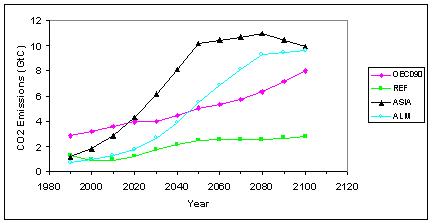
Figure 1. Projected carbon dioxide emissions from four country groupings as defined by the IPCC’s A1FI scenario. For a description of the country groupings, see the text. (source: IPCC SRES)
The IPCC breaks the world down into four general classifications —OECD90 (industrialized countries including the U.S., Western Europe, Australia and Japan), REF (countries undergoing economic reform including Eastern Europe, former Soviet Union and Sub-Saharan Africa), ALM ( North Africa, Latin America and the Middle East), and ASIA (Asian countries including China and India).
As can be seen in Figure 1, the emissions from each of the groups increase, with most of the increase in the first half of the century coming from the ASIA. In the last few decades of the second half of the 21st century, the IPCC projects the emissions from the OECD90 countries to quickly ramp upwards, despite slowed growth or even declines among other groups and despite little population growth. This seems like an odd expectation, but I digress…
Now, what I am going to do, through the help of MAGICC (a simple climate model which was developed to emulate the large-scale output of more complex climate models and which was designed to explore the impacts of different emissions scenarios on projected global temperatures), is show you what happens to future global temperature projections if the Waxman-Markey emissions limitation provisions were adopted (and adhered to) by the U.S. And while I’m at it, I’ll take you through the impacts of the adoption by the other regions as well.
Figure 2 is the same as Figure 1, except that I have adjusted the future OECD90 emissions to account for a reduced contribution from the U.S. assuming we stick to the Waxman-Markey emissions schedule.
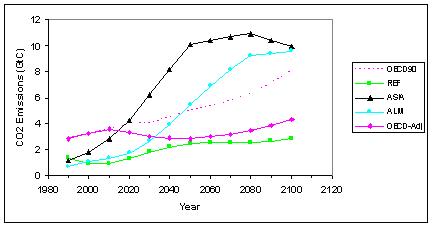
Figure 2. Same as Figure 1, except the original OECD90 pathway (dotted pink line) has been modified to account for the U.S. adherence to the Waxman-Markey emissions schedule (solid pink line).
Figure 3 shows what happens to global temperature projections when the MAGICC model is run with the original A1FI emissions pathways (shown in Figure 1) as well as when it is run under the modified A1FI scenario to include U.S. reductions (shown in Figure 2). The net result on the projected future global temperatures of a full adherence to the stipulations of the Waxman-Markey Climate Bill is a temperature “savings” of 0.06ºC by the year 2050, increasing to about 0.20ºC by the end of the century.
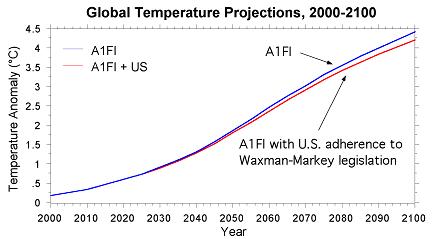
Figure 3. Projected global temperatures under the A1FI scenario (blue) and the A1FI scenario modified for a U.S. adherence to the Waxman-Markey emissions reductions schedule (red).
So, there you have it—going it alone, the U.S. succeeds at only managing to knock off two-tenths of a global temperature rise projected to be nearly 4.5ºC by 2100. Not a whole lot of bang for the buck.
So, clearly we (Americans) need a little, er, a lot of help.
In Figure 4, I depict what happens to the A1FI emissions pathways if every country of the world decided that the plan drawn up by Representatives Waxman and Markey was something that it could not live without and joined in the effort. Most notably, instead of the rapid rises in ASIA emissions that are projected to occur through the half of the 21st century, the emissions there top out by 2010 and decline sharply thereafter—despite a growing population and rapid industrialization—that’ll be a neat trick to pull off!
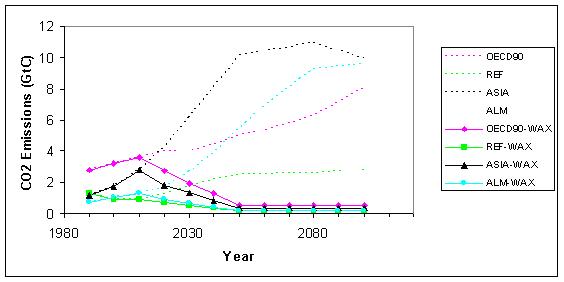
Figure 4. Same as Figure 1, except that all groups adhere to the Waxman-Markey emissions reduction schedule. Dotted lines are the original A1FI pathways, solid lines are the modified pathways.
Figure 5 shows the projected global temperatures with the different country groups signing on (i.e. MAGICC run with the modified emissions scenario depicted in Figure 4).
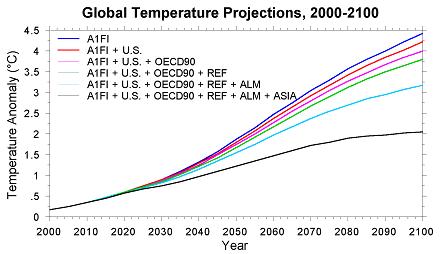
Figure 5. Projected global temperatures under the A1FI scenario (blue) and the A1FI scenario modified for an adherence to the Waxman-Markey emissions reductions schedule by all countries in the world in succession.
The top curve in Figure 5 (the greatest temperature rise) is projected to occur under the unfettered A1FI scenario. The bottom curve (the least temperature rise) occurs with everyone on-board. The curves in the middle show who contributes what. The U.S. acting alone under Waxman-Markey (as we have seen) reduces the projected global temperature rise by the year 2100 by 0.195ºC, if the rest of the OECD90 countries come along, the reduction increases to 0.402ºC—still less than 10% of the total projected rise. Even with the help of the REF countries, we only get a reduction of 0.602ºC. When the temperature rise really starts to show a decent slowdown is with the cooperation of the ALM countries (a reduction 1.241ºC). And, of course, the biggest impact, nearly as large as everyone else combined, comes from the ASIA countries. If they alone reduce emissions in line with Waxman-Markey suggestions, they will produce a 1.129ºC decline, and when acting along with everyone else they bring the total temperature reduction to 2.37ºC—a rise that is more than 50% smaller than projected under the original A1FI scenario. Nothing to sneeze at.
(Again, let me stress that I am describing the impacts on projected global temperatures. There is growing evidence that actual global temperatures are not evolving the way projections indicate that they should. So, the degree to which these temperature projections described above reflect what really will happen in the future, is far from certain.)
Conclusion
So, the key to producing a meaningful change in the course of projected global temperatures is to make sure that those countries of the world which are projected to have the greatest contributions to future emissions growth—primarily the countries in the ALM and ASIA group—take the actions to insure that those growth projections are not met.
The United States has an extremely limited direct role to play in projected future global climate—internal emissions reductions do virtually nothing. So, plans like the Waxman-Markey Climate Bill really don’t serve to change the climate in and of themselves. Instead, their purpose is to attempt to spur technological innovation and set an example as to what can be done to reduce emissions—with Americans serving both as the experimenters and the guinea pigs. It is not the climate impact of our experiment that is of any significance, but instead it is the tools that we may develop in attempting to achieve major emissions reductions. for the only truly effective course of action we have available to us in attempting to control the future course of global climate is to tell the rest of the world what to do and how to do it.
Let’s hope they are agreeable—for “we” (Americans) are setting ourselves up to take a great risk for which the outcome, both internally and externally, is far from certain.
Chip,
Part III – “…but the temperature still rises.”
Outline:
Total global cessation of carbon emissions (“The 100% Solution”)
Total global cessation of domesticated animal husbandry (“The Vegan Solution” – UN FAO estimates 18% of GHGs from domesticated animals.)
Global population controls (“The what do you do when you have 10 billion humans breathing and eating legumes for protein Solution.”)
The above should achieve stabilization of atmospheric carbon concentrations.
I shall await the decision by the “consensed scientists” and the “committed politicians” to share this “ultimate solution” with the “great unwashed”. Their choice of “focus grouped” phrases to make this sound appealing should be the “Eighth Wonder of the Modern World”.
[…] We all know this. Why do we continue with the charade that we are doing something about it? The ability of the industrialized world, through emissions reductions alone, to impact the future co…. If the U.S., Canada, Australia, Japan, Europe, and former Soviet countries all limited their […]
[…] Be sure not to miss Part II of this analysis, where I take a look at what happens if the rest of the world wants to play […]
Of course, anything approaching such reductions is pretty damn impossible.
http://en.wikipedia.org/wiki/Montreal_Protocol
Whenever I start thinking the worse of the rest of humanity I remind myself of the Montreal Protocol. You guys should, too. 🙂
Two basic questions come to mind reading your analysis.
1. If total emissions growth has increased dramatically, why isn’t this showing up in the Hawaiian atmospheric CO2 ppm measurements?
2. If atmospheric CO2 ppm does increase, exactly what “part” of the million is being displaced by the new CO2 part? For example, if CO2 increases to 600 ppm from 380 ppm by end of century, doesn’t that mean some other “part” has decreased by 220 ppm?
[…] Gas-Induced Climate Change), the simple climate model Chip Knappenberger used in two recent posts to calculate potential global warming reductions from the Waxman-Markey […]
CO2 Newbie.
1. What makes you think it hasn’t? The rate of increase continues to increase despite the (admittedly limited) efforts at reduction. It does vary a lot from year to year because of other factors like plant growth.
2. Well, there’s been a measurable decrease in oxygen in the atmosphere because when you burn a carbon atom it takes a molecule of oxygen to make a CO2 molecule. That’s where a lot of it has gone. But there are a number of “parts”, nitrogen (N2, 78.08%), oxygen (O2, 20.95%), argon (0.93%), water vapor (about 1%) and traces of other things. The increase in CO2 (0.038%) affects them all to some extent. N2 is 780,800 ppm so if you decreased that by 78% of 220 then N2 is 780, 638 ppm. That’s only a 0.021% decrease in nitrogen but a 57.9% increase in CO2.
riverat,
1. When I view the NOAA CO2 pages, the constant growth of ppm (with seasonal ups/downs) does not seem to reflect the dramatic growth in actual emissions. In addition, this data (http://wattsupwiththat.com/2009/03/21/recent-ocean-heat-and-mlo-co2-trends/) suggests growth rate of CO2 ppm has been reduced.
2. Yep, the oxygen ppm decrease makes sense due to burning carbon. But does CO2 ppm increase actually cause a decrease in N2, for example? How does that work?
Thanks.
So is the argument that I can look forward to a guilt-free fossil fuel-indulged life as I now know my grand kids will suffer global warming catastrophe whatever I do?
Or should we be arguing for stronger measures than what has been proposed?
[…] sophisticated arguments going around against the Waxman-Markey energy bill is to point out that even if implemented the world will still get a lot warmer as long as China, India, and the rest of the developing world don’t restrain their emissions […]
Granting that the numerical portion of your analysis is generally correct, your conclusion does not follow. I’ll stipulate that the most important steps to be taken involve achieving the participation and cooperation of Asia, India, etc. and that the most important thing “we” can do is to elicit this result. How can we do so?
I don’t think it will be by saying “our part is small, look at the figures. Therefore we will continue doing what we’ve done to contribute a large multiple (per capita) of your CO2 emissions while we coerce you into stabilizing your population and managing your economies in a way completely different than the way we’ve managed ours.”
What sane person or nation would accept that? Therefore, our willingness to manage our economies in such a way that we achieve emissions goals is key to any chance we have of convincing “the other guys” to contribute.
“The Missing Hotspot” (Dr David Evans in http://www.sciencespeak.com) shows that the IPCC’s models and theory on human induced global warming to be wrong,.
This is confirmed by “Temperature measurements show that the [climate model-predicted mid-troposphere] hot zone is non-existent. This is more than sufficient to invalidate global climate models and projections made with them!”- UN IPCC Scientist Dr. Steven M. Japar, a PhD atmospheric chemist who was part of Intergovernmental Panel on Climate Change’s (IPCC) Second (1995) and Third (2001) Assessment Reports, and has authored 83 peer-reviewed publications and in the areas of climate change, atmospheric chemistry, air pollutions and vehicle emissions.
See U.S.Senate Committee on the Environment and Public Works Minority page.
Chinese research contradicts the IPCC and says it is wrong. Search “Lin Zhen-Shan and Sun Xian”
This debate does not take place in a vacuum. In the current economic downturn, China’s economy is still expected to grow by , what, 6-8%? In a mere 20 years it will quadruple, 30 years 8 times, generations before 2100 about which there is, apparently, concern.
President Obama risks being judged harshly by history for contributing to U.S. demise and China’s ascendancy by handing China an enormous economic advantage in a Canute-like attempt to control the climate, in the face of evidence that it is just that.
[…] I demonstrated in my analyses last week (here and here), the impact on global temperatures of U.S. actions to reduce greenhouse gas emissions pursuant […]
So, all that great analysis, and then you ruin it by drawing entirely the wrong conclusion. Faced with the evidence that the most ambitious proposal on the table will have only a tiny impact on the overall problem, you conclude that we shouldn’t do it. A far more defensible conclusion is that we should do it, and treat it as the first step in a much bigger endeavor. Or I suppose we could just throw up our hands in despair, and hand our descendants a wasteland.
The journey of a thousand miles starts with the first step.
[…] Part I is here; Part II here. […]
[…] Article Part 2: http://masterresource.org/?p=2367 […]
Great article. This kind of measured, informed and approachable commentary on climate change is in short supply on the web.
You say that, “There is growing evidence that actual global temperatures are not evolving the way projections indicate that they should. ”
Can anyone provide data or links on that?
There are critical flaws in the whole AGW theory, not the least of which is the absence of warming in the low latitude mid-troposphere — which would ordinarily be recognized as a refutation of a scientific hypothesis (if it were not intertwined with politics). Waxman and Markey refuse to consider this, of course, so it’s pointless to argue with them about it. But the important point is that China and India do recognize it. There is no way these countries are going to forgo economic development and agree to any reductions in CO2 emissions in the face of what they regard as questionable or flawed scientific theory. As Chip’s calculations show, any hope of affecting global temperature without their participation — even assuming the models are correct and affecting global temperature is feasible — is delusional and narcissistic. At an extroardinary cost to poor and middle class Americans.
John Doe,
Check out these articles for evidence that global temperatures are not evolving the way climate models (especially when run with the IPCC emissions scenario that we are currently closest to) project that they should be:
Observations and Model Projections
Recent Temperature Behavior
Climate Sensitivity
-Chip
Chip, go here see a proper analysis:
http://www.pik-potsdam.de/news/press-releases/on-the-way-to-phasing-out-emissions-more-than-50-reductions-needed-by-2050-to-respect-2b0c-climate-target
Yuebing,
Note that this “proper analysis” requires near zero net emissions GLOBALLY by 2050. There is not now, nor has there ever been, a plan to achieve that result. Waxman-Markey certainly would not, even if adopted in principle by the entire developed world.
The estimated investment to achieve that result by 2050 is ~$100-150 trillion, or $2-4 trillion per year over the period. With all of the excess investment capital floating around in the world economy today, that shouldn’t present much of a challenge!
[…] http://masterresource.org/?p=2367 […]
[…] http://masterresource.org/?p=2367 Possibly related posts: (automatically generated)The Benefits of Waxman-MarkeyOil companies call Waxman-Markey clean energy bill ’unfair’ […]
[…] One argument against doing anything about climate change is that, even if we were to implement something like the Waxman/Markey bill currently being debated in the Senate, we would get very little reduction in greenhouses gases unless China, India, and the rest of the developing world also get on board. But because U.S. legislation has no power to compel others to cooperate, such legislation is useless. […]
” So is the argument that I can look forward to a guilt-free fossil fuel-indulged life as I now know my grand kids will suffer global warming catastrophe whatever I do?”
There is no climate catastrophe waiting.
The models are crappy, overstated and wrong, the earth hasnt warmed in 10 years, and the earth is not warming at the rate they project anyway. The way they model water vapor was skewed to overstate warming by a factor of 2X to ramp up the alarmism. Doubling CO2 in the atmosphere will give us no more than 1.5C increase, probably less (Viz Prof Spencer and “Climate Confusion”).
the other real story is that quadrupling CO2 emissions will be IMPOSSIBLE just from a resource limitation POV. The real story here is that we could get 90% of the temperature reductions from waxman-markey by freezing CO2 emissions at current levels globally by say 2030 … which will happen anyway just from Peak Oil! So if we freeze Co2 emissions sometime by 2030 or so by simply evolving away from fossil fuels naturally (no regs needed just supply and demand and technology alternatives that get better like nuclear and solar) we will be find. …. end of crisis, no need for drastic and useless and job-killing regulation.
“Or should we be arguing for stronger measures than what has been proposed?”
Hitting yourself in the head with a hammer does not cure a headache… But to global alarmists, the fact that something wont work just means we should just redouble our efforts.
But you can ignore the reality that it wont work and live the myth of climate alarmism: Go for it. Keep hitting yourself with that hammer even harder and tell us how it goes.
I would add that something is wrong with the model, based on the output. Recent Science has shown that the lag effect or warming ‘in the pipeline’ is no more than 5-8 years, yet the model shows that even if the emissions were cut to almost nothing, the warming continues. This shows that it is modelling a lag effect warming increase that isnt there or is more muted than modelled.
I think those who argue that the Conclusion should be “Any response needs to be a Global Response” … that is valid.
So I think it would make sense therefore to scrap Waxman-Markey and replace it with a regulation setup that has 2 triggers:
1. Temperature and CO2 increase trigger, ie, it only gets put into place if CO2 AND temperature passes a threshold (say go above 1998 temps). There is no sense implementing if this is a false alarm.
2. Global regulation trigger, ie, it only gets implement if China and India and the other G-8 nations pass similar regulations. There is no sense implementing if China and India wont do it.
[…] by 2050 would still be less than 0.5° C. Knappenberger’s analysis is given here and here, and assumes the IPCC mid-range or high-range emissions scenarios; for low-range scenarios the […]
Anyone who thinks the Chinese are going to follow our example and risk destroying their economy is beyond naive. This coming from a westerner living in and doing business in Beijing for many years.
[…] All figures come from MasterResource. […]
[…] Change – National Center for Atmospheric Research – Environmental Protection Agency [↩]qui e qui trovate la trattazione completa […]
[…] bill would have on future climate. It turns out that it is totally ineffectually and even getting the whole world to take part doesn’t help much. The idea of “stopping” climate change is so […]
[…] The Democrats could barely pass Waxman-Markey with an overwhelming majority, and that bill will do little to alleviate greenhouse gas […]
[…] Climate Impacts of Waxman-Markey (Part II)—Global Sign-Up 2,165 Views (Chip Knappenberger) […]
[…] climate policies would avert. That’s hardly surprising, since as Chip Knappenberger has demonstrated, reducing U.S. emissions 83% below 2005 levels by 2050 — the Waxman-Markey […]
This report ignores the so-obvious reality that China & India are unlikely to shift to a clean energy future without US leadership.
The US is the leader in international politics, as the hegemonic player, and needs to wake up to this responsibility. Other EU countries are setting targets and doing their bit, but the US has their head in the sand because it’s such a “challenge”. Why cannot it be seen as an opportunity? The US can shift from finite depletable resources to sustainable sources; which will have to occur in the long-term anyway.
Travis Monitor – I suggest you educate yourself on the methane hydrates under the Siberian permafrost, and other tipping points.
For those who think forcing GHG reductions is the “right” thing to do for our grand children, even if it does not begin to save the planet from itself (if, in fact, it actually needs saving), keep this in mind.
My rough calculation for the electric power sector, which is responsible for about 40% of U.S. anthropogenic CO2 emissions, indicates that to reduce emissions from that sector by just 20% (about 450-500 million tons per year) via a calculated move to a “cleaner” energy mix (less fossil, more nuke and renewable) will cost us about $1 trillion. And that 20% reduction will clearly have a wholly insignificant global effect, so we will need to do much more than that. So how many trillions will it take from the electric sector? From the transportation sector? From the industrial sector? How many trillions can we afford or have the conviction to throw at this?
I, for one, want to avoid burdening future generations with outrageous and unnecessary debt simply because we spent that money for no real effect but had hopes that China and others just might follow along, in which case there will still be no guarantee that our climate will be significantly different that if we had done nothing at all.
Folks – this is a global issue that, at the very least, REQUIRES a coordinated global assessment, concurrence and action plan, if necessary.
[…] All figures come from MasterResource. […]
[…] far more than would any wind-power subsidies. However, the Waxman–Markey bill would (at best) moderate world warming by only 0.11 degrees centigrade by the end of this century. Posted in Energy and Environment Print This […]
[…] the NRDC plan will do virtually nothing to moderate global warming—even if you believe the high-end sensitivity estimates of the Intergovernmental Panel on Climate […]
[…] greenhouse gases would not make a dent on global emissions and only moderate temperatures a few tenths of a degree Celsius over the next 85 […]
[…] Part II – we […]